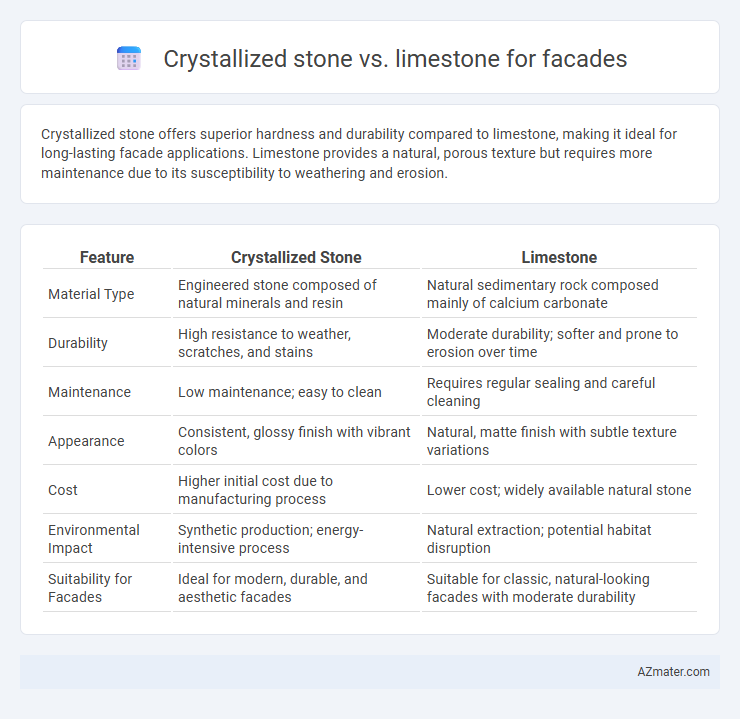Crystallized stone offers superior hardness and durability compared to limestone, making it ideal for long-lasting facade applications. Limestone provides a natural, porous texture but requires more maintenance due to its susceptibility to weathering and erosion.
Table of Comparison
| Feature | Crystallized Stone | Limestone |
|---|---|---|
| Material Type | Engineered stone composed of natural minerals and resin | Natural sedimentary rock composed mainly of calcium carbonate |
| Durability | High resistance to weather, scratches, and stains | Moderate durability; softer and prone to erosion over time |
| Maintenance | Low maintenance; easy to clean | Requires regular sealing and careful cleaning |
| Appearance | Consistent, glossy finish with vibrant colors | Natural, matte finish with subtle texture variations |
| Cost | Higher initial cost due to manufacturing process | Lower cost; widely available natural stone |
| Environmental Impact | Synthetic production; energy-intensive process | Natural extraction; potential habitat disruption |
| Suitability for Facades | Ideal for modern, durable, and aesthetic facades | Suitable for classic, natural-looking facades with moderate durability |
Introduction to Crystallized Stone and Limestone Facades
Crystallized stone facades offer exceptional durability and aesthetic appeal due to their engineered composition, which combines natural stone powders with resins to create a non-porous, stain-resistant surface. Limestone facades, known for their classic and timeless appearance, provide natural breathability and thermal insulation but require regular maintenance to prevent weathering and erosion. Choosing between crystallized stone and limestone facades depends on desired longevity, maintenance requirements, and architectural style preferences.
Material Composition and Formation
Crystallized stone, formed through rapid cooling and solidification of molten magma, exhibits a dense, interlocking crystalline structure primarily composed of quartz, feldspar, and mica, offering high durability and resistance to weathering for facades. Limestone, a sedimentary rock mainly composed of calcium carbonate from marine organisms' skeletal fragments, features a porous texture that may be more susceptible to erosion and acid rain damage over time. The fundamental difference in their geological formation processes directly influences their physical properties and suitability for exterior cladding applications.
Visual Appeal and Aesthetic Options
Crystallized stone offers a high-gloss, reflective surface that enhances modern architectural designs with its sleek, polished finish, while limestone provides a more natural, matte texture ideal for classic and rustic facades. Crystallized stone's vibrant color variations and translucency create dynamic visual effects, whereas limestone's subtle grain and earth-toned palette lend warmth and timeless elegance. Both materials allow for versatile aesthetic options, but crystallized stone stands out for contemporary, eye-catching facades, and limestone suits traditional, understated elegance.
Durability and Weather Resistance
Crystallized stone offers superior durability and enhanced weather resistance compared to limestone due to its denser, non-porous surface that resists moisture infiltration and erosion. Limestone, while aesthetically appealing, is more susceptible to acid rain degradation, freeze-thaw cycles, and surface wear over time. Choosing crystallized stone for facades ensures a longer-lasting, low-maintenance exterior capable of withstanding harsh environmental conditions.
Maintenance Requirements and Longevity
Crystallized stone offers superior durability and low maintenance requirements compared to limestone, resisting weathering and staining due to its dense, non-porous structure. Limestone, although aesthetically appealing, tends to require frequent sealing and cleaning to prevent erosion and discoloration caused by acid rain and pollutants. Over time, crystallized stone typically exhibits greater longevity in facade applications, maintaining structural integrity and appearance with minimal upkeep.
Sustainability and Environmental Impact
Crystallized stone offers superior durability and lower maintenance compared to limestone, reducing the need for frequent replacement and thus minimizing environmental impact over time. Limestone, while natural and abundant, involves higher carbon emissions during quarrying and processing, contributing to greater ecological disruption. Choosing crystallized stone supports sustainability by enhancing facade longevity and lowering the overall carbon footprint in building applications.
Cost Comparison and Budget Considerations
Crystallized stone typically commands a higher price than limestone due to its enhanced durability and aesthetic appeal, influencing overall project budgets significantly. Limestone offers a more cost-effective facade solution but may incur increased maintenance expenses over time, impacting long-term financial planning. Budget considerations should factor in initial material costs, installation complexity, and lifecycle maintenance to optimize facade investment efficiency.
Installation Process and Technical Aspects
Crystallized stone offers a more uniform and dense surface compared to limestone, resulting in easier cutting and polishing during the installation process. Limestone, being softer and more porous, requires careful handling and sealing to prevent damage and weathering over time. The technical aspects highlight crystallized stone's superior durability and resistance to stains, making it ideal for high-traffic facades, whereas limestone demands regular maintenance to preserve its aesthetic and structural integrity.
Applications in Modern and Traditional Architecture
Crystallized stone offers superior durability and low maintenance, making it ideal for modern architectural facades that demand sleek, polished surfaces with high resistance to weathering and pollution. Limestone, favored in traditional architecture, provides a timeless, natural aesthetic with its porous texture and warm tones, often used in historic restorations and classical building designs. Both materials excel in facade applications, but crystallized stone suits contemporary styles while limestone preserves historical authenticity in architectural projects.
Choosing the Right Facade Material for Your Project
Crystallized stone offers superior durability and an elegant, glossy finish that withstands weathering better than traditional limestone, making it ideal for high-end facade projects seeking longevity and aesthetic appeal. Limestone provides a natural, textured look with excellent thermal insulation properties but requires more maintenance due to its porosity and susceptibility to erosion. Assessing the project's climate, budget, and desired visual effect is crucial when choosing between crystallized stone and limestone to ensure optimal performance and design coherence.

Infographic: Crystallized stone vs Limestone for Facade
 azmater.com
azmater.com